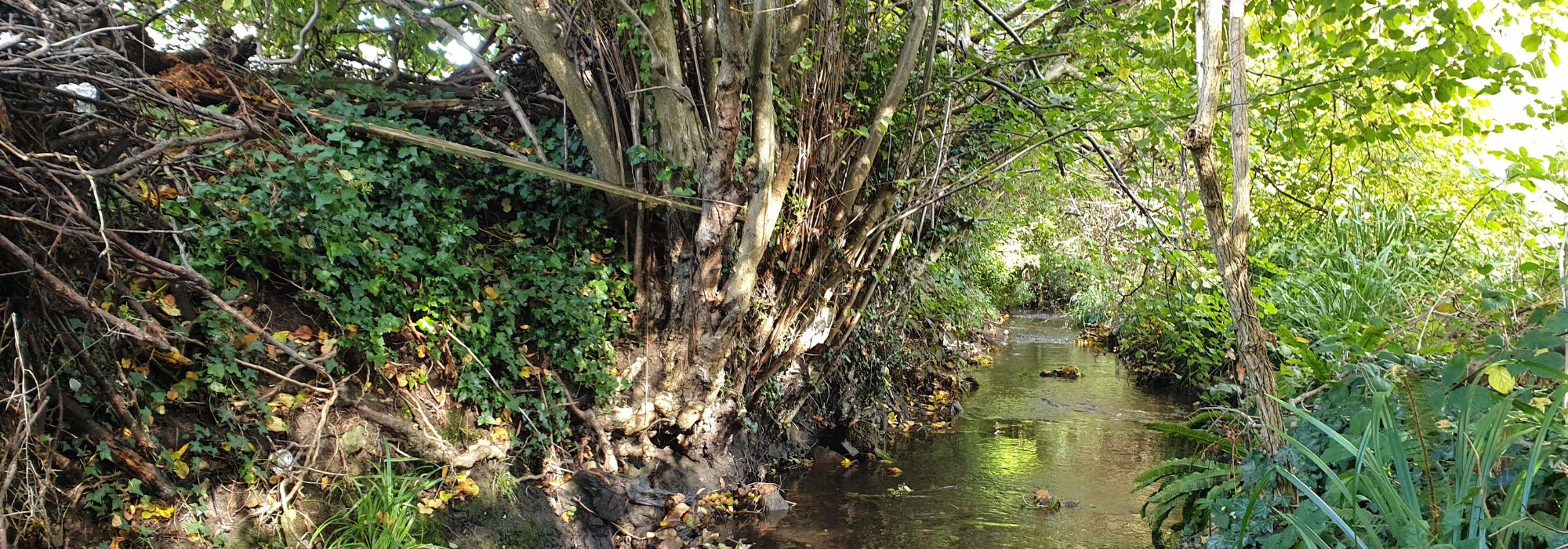Quaggy Habitats – Capel Manor Project
The River Quaggy
The River Quaggy is a 17km river flowing through the London Boroughs of Bromley, Greenwich and Lewisham before joining the River Ravensbourne, one of the tributaries of the River Thames, in central Lewisham. The Quaggy experiences similar pressures to many of the rivers in Greater London, with large stretches of modified concrete channels and culverts, as well as water quality issues created by road runoff, misconnections, and urban pollution. These factors all lead to reduced overall ecological quality of the Quaggy.
Working in collaboration with the Quaggy Waterways Action Group (QWAG) and the local community, including residents living in the Horn Park/Mottingham Lane area, we will aim to improve the River Quaggy and its surrounding area by actions such as adding woody material to the river, removing fly-tipped waste from its banks, and clearing channels to existing wetland pools in the bank area. This can improve both the river and bank habitat, providing more space for wildlife to flourish.
Importance of river habitat diversity
In essence, rivers provide multiple environmental benefits to the landscape. They directly provide habitat for aquatic animals and plants, as well as forming crucial connections between aquatic features like wetlands, floodplains, and ponds for aquatic animals to move between and take refuge in.
A natural river with minimal modifications is a constantly changing feature with many different habitat types, including riffles (areas of shallow, fast flowing water), pools (areas of deep, slow flowing water), and backwaters. A river in this state is also closely connected to its floodplain, creating wetland areas and further habitat diversity, as well as reducing downstream flood risk and buffering the system against pollution.
When rivers are modified into straighter channels, encased in concrete or diverted through culverts, the habitat diversity of the natural river is lost, connection to the floodplain disappears, and flow speed and depth become un-naturally consistent. This is the case with some reaches of the Quaggy.

River Restoration on the Quaggy
The Quaggy in this area (Capel Manor College, Mottingham Lane, Dutch House/A21) demonstrates a modified and overwidened channel, threatened by high pollution levels from misconnected household pipes from baths, toilets, sinks, and fly tipping.
Situated next to an area of wet woodland, however, it presents a great opportunity for restoration work, under the Environment Agency’s Water Environment Improvement Fund, to help improve the ecological quality of the river.
The natural diversity of river habitats will be mimicked here through a variety of measures, including the installation of flow deflectors (structures to push water in different directions) made from locally felled trees and the creation of brush berms (low level shelves in the river made from tree material which collects sediment with time).
These structures return the diversity of flow speeds and depths to the river, reflecting more natural conditions. The existing wet woodland alongside this stretch of the Quaggy will also be developed to provide additional habitat for invertebrates and young fish.

As part of this project, and in collaboration with the Quaggy Waterways Action Group (QWAG), there will be a number of opportunities for local community involvement. These will include river clean up events, to address the build-up of fly-tipped waste on the river banks, and vegetation management events to prepare the site for the restoration works. There will also be opportunities to attend Thames21’s flagship training courses, Leading Action for Healthy Rivers and Vital Signs of Healthy Rivers, which are designed to enhance local knowledge on the value of environmental and ecological river resilience, as well as to enable community groups to run their own events on their local rivers.
Please view pictures from our events by clicking link here: https://rb.gy/fl0ahr. Community members can also have their say on Thames21’s restoration plan, pictured below, and provide their thoughts on this stretch of the river in general by using this Google Form to submit their feedback. We look forward to hearing from you!
For more info, contact: jo.goad@thames21.org.uk or miguel.sanabria@thames21.org.uk or carolina.pinto@thames21.org.uk
In partnership with:



